Information Processing | Chapter 7 | 8th Maths - Principles of Counting | 8th Maths : Chapter 7 : Information Processing
Chapter: 8th Maths : Chapter 7 : Information Processing
Principles of Counting
Principles
of Counting
There are
some basic counting techniques which will be useful in determining the number through
different ways of arranging or selecting objects. The basic counting principles
are given below.
1. Addition
principle
If there
are two selections such that they can be done independently in m ways
and n
ways respectively, then either of the two selections can be done in (m + n) ways.
Let us learn
about this addition principle of counting as given below :
Situation:
In class VIII, there are 16 boys and 9 girls. The teacher wants to select either a boy or a girl as the class leader. Let us see, in how many ways can the teacher select the class leader.
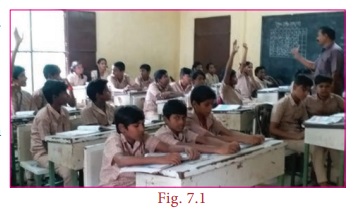
The teacher
can select the class leader in any one of the following ways.
(i) In the
first choice, the teacher can select a boy
among 16 boys in 16 ways (who ever may be of the 16 boys).
(ii) In the
second choice, the teacher can select a girl
among 9 girls in 9 ways (who ever may be of the 9 girls).
Hence, the
teacher can select the class leader who is a
boy or a girl in 25 different
ways (16 boys
+ 9 girls).
Thus, we
come to know, if a selection A can occur
in m ways and another selection B can occur in n
ways, and suppose that both cannot occur together, then A or B can occur in (m + n)
ways. Let us see an example.
Example 7.1
If you are
going to a hotel to have food and the hotel offers different food items as shown
in Fig 7.2. Find how many ways are possible to have either tiffin or meals?
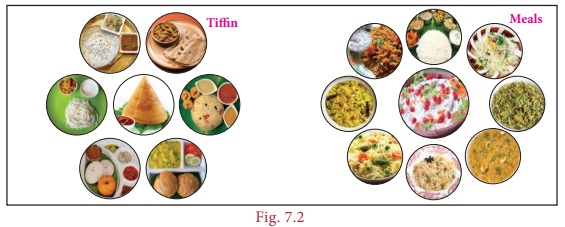
Solution:
From the
above Fig. 7.2, we come to know
(i) For tiffin,
we can choose one among 7 items in 7
ways
(ii) For
meals, we can choose one among 9 items
in 9 ways.
Therefore,
there are 16
(7
tiffin items + 9 meals items) different ways by which we can choose any one food.
2. Multiplication
principle
If a selection
can be performed in m ways, following which another
selection can be performed in n
ways, and both the selections are dependent on each other then, the two selections
together can be performed in exactly (m
× n) different ways.
Now, we shall
learn about multiplication principle of counting from the following situation.
Situation:
There are
3 places in a city namely A,B and C. There are 3 routes a1, a2 and a3 from A to B. There are 2 different routes, b1 and b2 from B to C as shown in the Fig
7.3.

Suppose a person wants to travel from A to C via B. Lets us see the number of ways he can go from place A to C via B.
(i) In the
first way, he can go from A to B in 3 routes and
(ii) In the second way, he can go from B to C in 2 different routes.
Therefore,
the total number of ways in which he can travel is 6 (3 × 2) routes as shown in Fig 7.4.
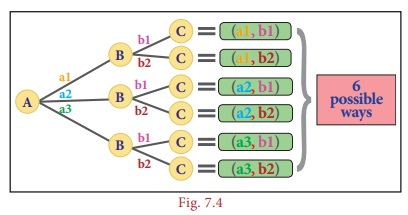
Thus, we
come to know, if a selection A can occur
in m ways and another selection B can occur in n
ways, and both the selections are dependent on each other then, the two selections
can be performed in exactly (m
× n) different ways. Let as learn more about
from the following examples.
Example 7.2
Praveen bought
3 shirts, 2 jeans and 3 pairs of shoes
for his birthday. In Fig. 7.5 shows the different ways of wearing the dress. In
how many different ways can Praveen wear a dress on his birthday?
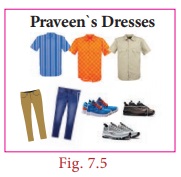
Solution:
Here, Praveen
has 3 shirts  , 2 jeans
, 2 jeans  and
and  3 pairs
of shoes.
3 pairs
of shoes.
He can wear
a dress either this way  or he can have the choices as shown in the
Fig. 7.6
or he can have the choices as shown in the
Fig. 7.6
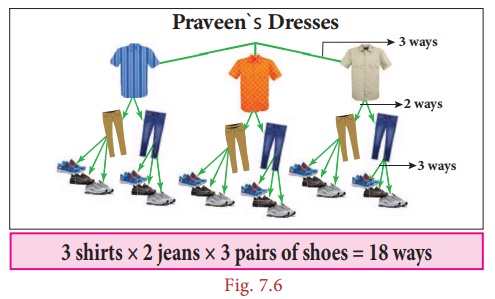
Therefore,
Praveen can wear his dress in 18 (3×2×3)
different possible
ways on his birthday.
Example 7.3
In class
VIII, a math club has four members M,A,T
and H. Find the number of different ways,
the club can elect
(i) a leader,
(ii) a leader
and an assistant leader.
Solution:
(i) To elect a leader
In class
VIII, a math club has four members namely M, A, T and H.
Therefore,
there are 4
(4 × 1) different ways
by which they can be elected a leader.
(ii) To elect a leader
and an assistant leader
In the
Fig. 7.7, the red
shaded boxes show that same member comes twice. As, one person cannot have two
leadership, therefore, the red shaded boxes cannot be counted. So there are
only 12
((4 × 1 × 4) – 4) different ways (shown in yellow boxes and
green boxes) to choose a leader and an assistant leader for the math club.
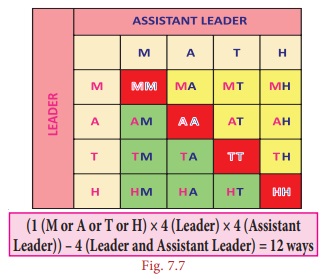
Activity
1. Determine the
number of two digit numbers that can be formed using the digits 1, 3 and 5 with
repetition of digits allowed.
The activity consists
of two parts
(i) Choose a one's
digit.
(ii) Choose a ten's
digit.
Complete the table
given beside
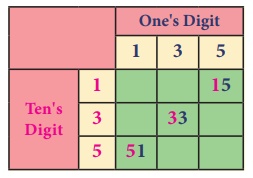
Solution:
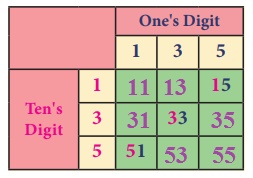
2. Find the three
digit numbers that can be formed using the digits 1, 3 and 5 without repetition
of digits.
Complete the tree
diagram given below to the numbers

Solution:

A password using 6
characters is created where the first 2 characters are any of the alphabets, the third character is any
one special character like @, #, $, %,
&, _,+,~, * or - and the last 3 characters are any of the numbers from 0 to 9. For that, there are 26 × 26 × 10 × 10 × 10 × 10 = 67,60,000 number of different
ways possible to create that password.
Example 7.4
In how many
ways, can the students answer 3 true or false type questions in a slip test?
Solution:
(i) Assuming
that the question Q1 is answered True, questions Q2
and Q3
can be answered as TT, TF, FT and FF in 4 ways.
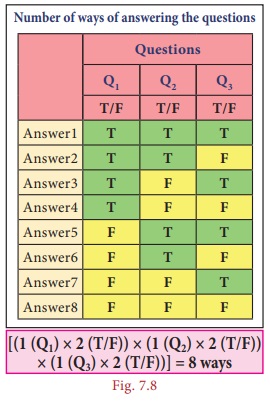
(ii) Assuming
that the question Q1 is answered False, Q2
and Q3
can also be answered as TT, TF, FT, and FF in 4 ways.
Thus, as
each question has only two options (True or False) in 2 ways, the number of ways
of answering these 3 questions in a slip test is 8 (2 x 2 x
2) possible ways as shown in Fig. 7.8.
Example 7.5
Madhan wants
to a buy a new car. The following choices are available for him.
• There are
2 types of cars as shown in the Fig.
7.9
• There are
5 colours available in each type as shown
in Fig. 7.9.
• There are
3 models available in each colour
(i) GL (standard model)
(ii) SS (sports model)
(iii) SL (luxury model)
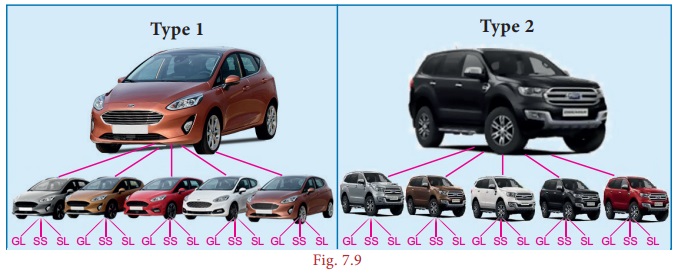
(i) In how
many different ways can Madhan buy any one of the new car?
(ii) If the white colour is not available in Type 2, then in how many ways can Madan buy a new car among the given option?
Solution:
(i) To buy
any one of the new car from the given choices
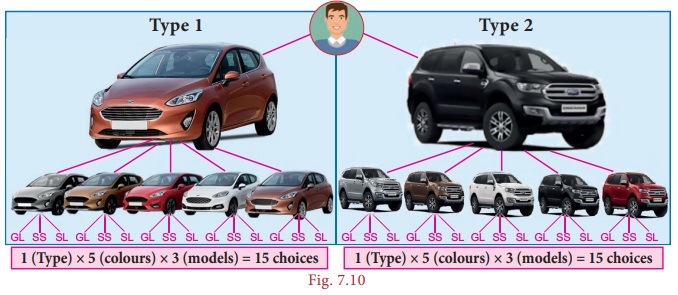
Here, we
have 2 types of car with 5 different colours and 3 models in each colour.
Therefore,
there are 30
[2 (1 × 5 × 3)] different ways to buy a new car by
Madhan.
(ii) If the
white colour is not available in Type 2, then...
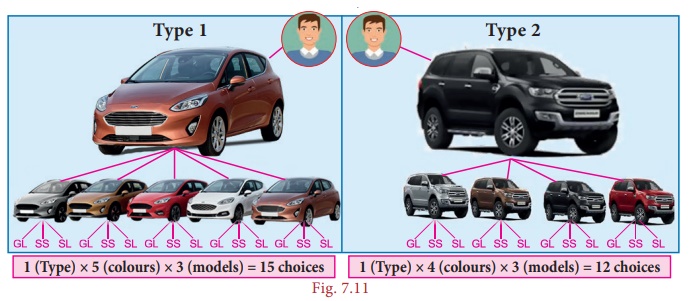
(i) For Type 1, we have 5 colours and 3 models and
hence there are 1 × 5 × 3 = 15 choices.
(ii) For
Type 2, we have only 4 colours and 3
models and hence there are 1 × 4 × 3 = 12
choices. Therefore, there are 27 (15 +
12) different
ways to buy a new car by Madhan
The above
example illustrates both the addition and multiplication principles.
Related Topics